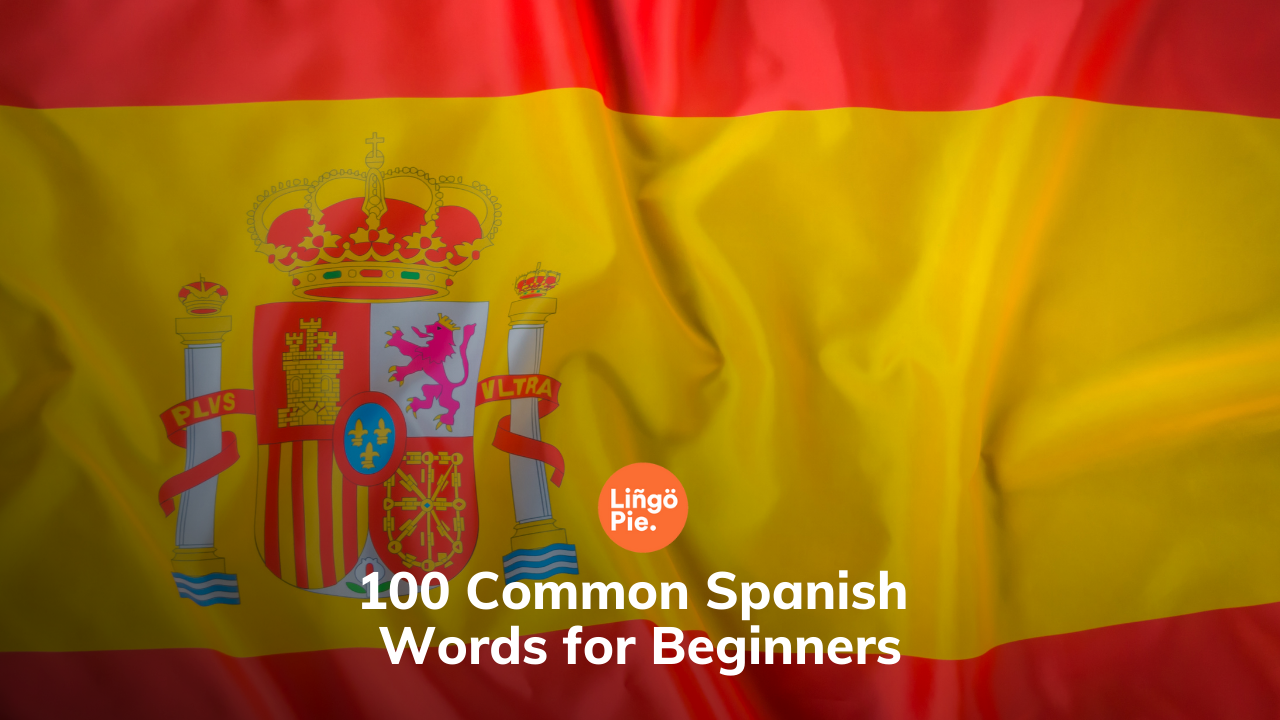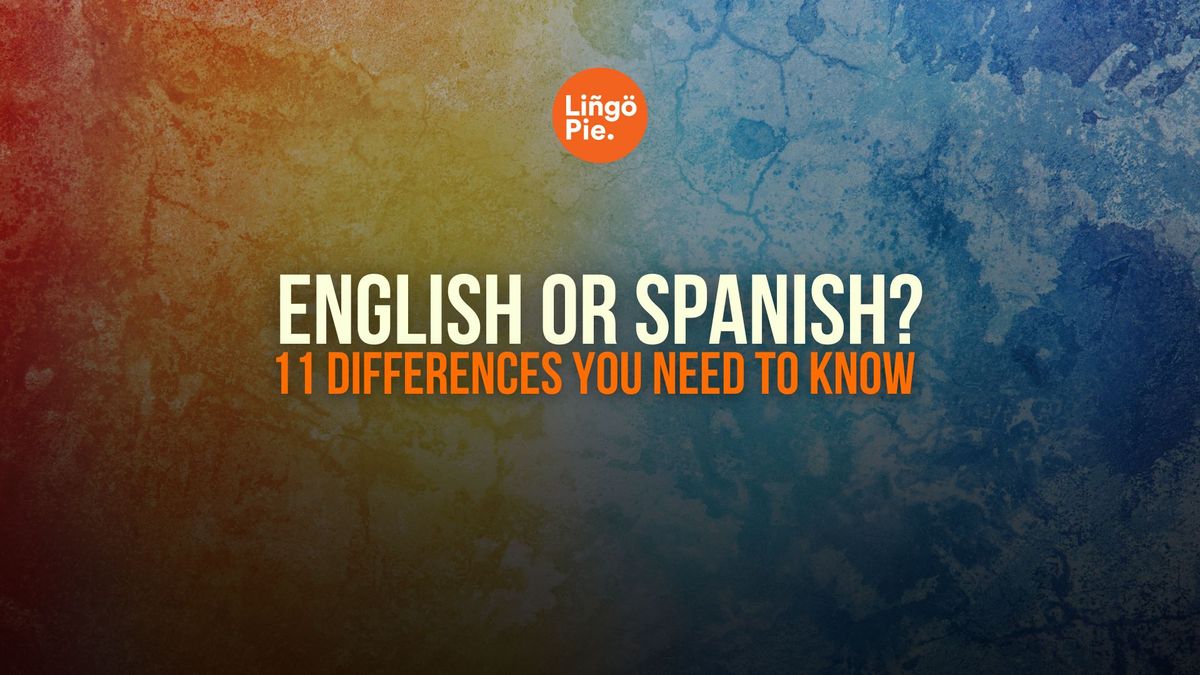One of the fun things about learning another language is the way it forces you to look at things differently. This is particularly true if you’re an English speaker learning Spanish.
Just because you memorize a bunch of vocabulary and grammar doesn’t necessarily mean you can speak the language — far from it!
No matter how far along you are in your journey to becoming bilingual, you’re bound to constantly discover differences between English and Spanish that will leave you scratching your head. Keep reading to find out what some of the most interesting ones are!
- How To Say Cheers In Spanish: 5+ Easy Toasts
- Spanish Curse Words: 20+ Crazy Bad Words In Spanish
- How To Become Fluent in Spanish: 5 Best Tips [2025]

English Vs Spanish
English and Spanish actually come from completely different language families – English is a Germanic language, while Spanish is a Romance language derived from Latin. While English shares its roots with German, Dutch, and Swedish, Spanish is more closely related to Italian, French, and Portuguese. This fundamental difference explains why these languages often feel like they're operating on entirely different wavelengths.
When you dig deeper, the contrasts become even more fascinating. Spanish follows much more consistent rules than English, especially in pronunciation and spelling.
Finding it confusing? Well, check out the table below to help you see some of the differences between English and Spanish.
| Feature | Spanish Language | English Language |
|---|---|---|
| Grammatical Gender | Has masculine and feminine nouns (el libro, la mesa) | No grammatical gender |
| Negation | Single negative (No tengo nada) | Double negative is incorrect |
| Word Order | More flexible (Me gusta el café = El café me gusta) | Generally strict SVO order |
| Spelling | Phonetic and consistent | Irregular and complex |
| Prepositions | Fewer, more versatile (en = in, on, at) | Many specific prepositions |
| Subject Pronouns | Often omitted (Voy al mercado) | Required (I go to the market) |
| Question Formation | Uses inverted punctuation (¿Cómo estás?) | No special punctuation |
| Verb Conjugation | Complex system with many forms | Simpler system, fewer variations |
 You will find more infographics at Statista
You will find more infographics at StatistaDifferences Between English And Spanish
The Spanish week has 8 days
OK, the week technically still only has 7 days in it, but when Spanish speakers talk about something happening a week from now they say “en ocho dias,” or “in eight days.”
This is definitely a hard one to understand for English speakers, but the easiest way to explain it is that basically, you count “today” as the 8th day in Spanish. You can take it one step further and say “cada ocho dias” when you’re talking about something happening every week.
Want to learn more about Spanish calendar terminologies? Check this Lingopie guide now!
A billion is 1,000 millions in Spanish
Sticking with the math theme, here’s another fun one. In English-speaking countries, we grow up learning that 1 billion is a 1 with 9 zeros after it: 1,000,000,000.
Well, in Spanish you say “mil millones” for the same number, which literally means “one thousand millions.”
Here's how it breaks down:
| English | Spanish | Number |
|---|---|---|
| Million | Millón | 1,000,000 |
| Billion | Mil millones | 1,000,000,000 |
| Trillion | Billón | 1,000,000,000,000 |
So when a Spanish speaker says "billón," they're actually talking about what English speakers call a trillion! It's one of those translation trip-ups that can lead to some pretty expensive misunderstandings.
There are fewer words in Spanish
Have you ever wondered how many words are in the Spanish language? Well, the "Diccionario de la Real Academia Española" lists approximately 88,000 words, with an additional 70,000 Americanisms, totaling around 150,000 words.
Of course, that doesn’t include all the regional variations of the language, each of which have tons of different colloquialisms that aren’t “official” Spanish words.
The English language, on the other hand, has roughly 1 million words according to the Merriam-Webster Dictionary. This huge difference is partly due to English's extensive borrowing from other languages, especially Latin and French, resulting in a larger lexicon.
If you're trying to wrap your head around the basic Spanish words completely, I recommend reading this guide 👇

Spanish nouns have a gender
Whether you took Spanish in high school or you’re teaching yourself Spanish, you probably already know this one. But it’s much more complicated than just the noun itself ending in “o” (for masculine) or “a” (for feminine).
The gender of the noun actually affects different parts of the sentence structure in Spanish. You have to use different forms of “the” depending on whether the subject is masculine or feminine: “el” or “la,” respectively.
You also have to modify other parts of the sentence, such as adjectives, depending on what gender the subject is.
Basically, words ending in '-o' are usually masculine (el plato, el vaso), while words ending in '-a' are typically feminine (la pluma, la silla). But watch out – there are exceptions like el problema (the problem) and la mano (the hand) that love to break these rules!
| English | Spanish | Gender |
|---|---|---|
| The table | La mesa | Feminine |
| The book | El libro | Masculine |
| The car | El coche | Masculine |
| The door | La puerta | Feminine |
As to the question of who decided that apples are feminine and shoes are masculine, we’ll probably never know.

There’s an extra letter in the Spanish alphabet
The only difference between the English and Spanish alphabet is that there are 27 letters in the Spanish alphabet. The culprit is an N with a squiggly accent line called a “tilde” over it: “Ñ.”
The “Ñ” (pronounced as en-ye) naturally comes right after the N in the alphabet. You’ll even find a separate key for it on Spanish keyboards (which have a completely different layout than their English counterparts, by the way).
| Word with Ñ | Pronunciation | Meaning |
|---|---|---|
| Niño | NEEN-yo | Child |
| Mañana | mah-NYAH-nah | Tomorrow |
| Español | es-pan-YOHL | Spanish |
| Señal | sen-YAHL | Signal |
Want to perfect your Ñ? Here are some popular Spanish shows on streaming platforms where you'll hear this unique sound in action.
- 17 Best Shows To Learn Spanish On Netflix [For Beginners]
- 8 Scary Movies In Spanish That Will Boost Your Language Skills
- 12 Best Spanish Christmas Movies To Watch This Holiday
Saying “I don’t want nothing” is grammatically correct in Spanish
Another one of the biggest differences between English and Spanish is the way you express negatives in Spanish.
In English, we have to mix affirmative and negative words to make negative statements. Take the following sentences as examples: “I don’t want anything” and “there is nothing.”
In Spanish, “no quiero nada,” or “no hay nada” are the correct translations of the same negative statements. The words “no” and “nada” are both negatives, so the literal translations back to English would be “I don’t want nothing” and “there is not nothing.”
Of course, you know that using a double negative is not grammatically correct in English, but it’s the proper way to express negatives in Spanish.
Spanish uses upside-down question marks and exclamation marks
If you’ve ever read a Spanish textbook or piece of literature, you probably noticed that questions and exclamations start with an upside-down question mark or exclamation mark — in addition to the right-side-up ones at the end of the sentence!
For example, the question “how are you?” would look like “¿como estás?” Weird, right? Or is it ¿right?
It’s less common to see the upside-down punctuation marks these days because people don’t normally use them when texting or in digital communications, but it’s still technically correct to use them in formal written Spanish.
Adjectives come after nouns in Spanish
When you're first learning Spanish, you might catch yourself saying things like "rojo coche" (wrong!) because you're thinking in English. Train your brain to follow this simple rule:
- Say the thing first
- Then describe it
For example, instead of saying “black dog” you would say “perro negro,” which literally translates to “dog black.”
There is, however, an exception to the rule. When the adjective is used to describe an innate quality of something, you put it before the noun.
For example, if you’re talking about your old house, i.e. where you used to live, you would say “mi vieja casa,” since you’re not talking about the actual age of the house. That house is always going to be your old house, regardless of when it was built.

The Spanish word for “from” means so much more
The word “de” in Spanish can be used in various ways to mean “of,” “by,” “with,” “in,”“than,” “at,” “about,” “out,” and “off”. It’s such a versatile little two-letter word!
Here are just a few examples of “de” in action:
- Soy de los estados unidos: I’m from the United States
- Me gusta trabajar de noche: I like to work in the night
- Estaba gritando de dolor: I was yelling with pain
In Spanish, you often use the verb for “to have” to express feelings
In English, when we have feelings, we say we “are” those things. If you’re hungry or cold, you would say “I am hungry” or “I am cold.”
In Spanish, you say you “have” those things, using the verb “tener.” If you’re hungry, you would say “tengo hambre,” literally meaning “I have hunger.” If you’re cold, you would say “tengo frío” or “I have cold.”
The verb “tener” is also used to express age. So, instead of saying “I’m 30,” you would say “tengo 30 años,” or “I have 30 years.”
There are two verbs for “to be” in Spanish
As if it wasn’t confusing enough learning Spanish, right? Luckily, it’s pretty easy to learn the difference between the two verbs.
The first verb for “to be,” “ser,” is used to describe more permanent qualities. For example, if you’re telling someone that you’re Canadian, you would translate “I am Canadian” to “soy canadiense,” because your nationality is never going to change.
The second Spanish verb for “to be” is “estar.” This one is used to describe more temporary qualities, such as emotions. For instance, if you want to say you’re excited, you would say “estoy emocionado.”
We said it was easy to learn how to use both verbs for “to be”, but there are some cases where you could use either, depending on the meaning you want to get across. But we don’t want to spoil the fun of learning Spanish too much...
If someone randomly asks "Do you speak English or Spanish?" these days, they might not be trying to start a conversation – they could be recreating @alfonsopinpon_'s viral TikTok prank! This involves asking people if they speak English or Spanish, then challenging them with "whoever moves first is gay" in the chosen language.
Which Language Should You Learn: English or Spanish?
While English dominates global business and tech, Spanish continues to grow rapidly, especially in the Americas. The good news? Both languages are highly practical – they're just practical in different ways.
| Area | English | Spanish |
|---|---|---|
| Career Focus | • Global business & tech • Scientific research • International academia • Remote work for global companies |
• Healthcare & education • Customer service • Local US businesses • Latin American markets |
| Geographic Value | • Global business language • Widely used in Asia & Europe • Universal tourist language |
• All of Latin America • Growing US market • Spain & Equatorial Guinea |
| Digital World | • 60% of internet content • Programming languages • Academic papers • Tech documentation |
• Second most used on social media • Growing online content • Large YouTube presence |
| Learning Curve | • Irregular pronunciation • Complex spelling rules • Idiomatic expressions |
• Phonetic spelling • Consistent rules • Similar to other Romance languages |
| Best For | • International business professionals • Academic researchers • Tech workers • Global travelers |
• US-based professionals • Healthcare workers • Latin America enthusiasts • Culture seekers |
Quick Decision Tip: Location often determines which to learn first – English for global reach, Spanish for Americas-focused opportunities. Already speak one? Learn the other – they're an unbeatable combination!
Are You Clear on the Differences Between English and Spanish Yet?
Clear as mud, right? We’ve really just hit the tip of the iceberg here when it comes to all the differences between the Spanish and English languages, and there’s no single answer to the question: what is the difference between English and Spanish?
They share some similarities, for sure, but they are two completely different languages with their own rules (and exceptions to those rules). Spanish speakers often find it just as confusing learning English as English speakers find learning Spanish!
Ultimately, how fast you can learn Spanish comes down to your methods, dedication, and personal learning style. The cool thing is that once you start really catching on to Spanish, you’ll probably start understanding English in ways you never did before! And to do that don't forget to try Lingopie for amazing Spanish learning with tv and Movies.
FAQs
Do you think it is harder for English natives to learn Spanish, or for Spanish natives to learn English?
The difficulty of learning a language depends on various factors, including the learner's environment, motivation, and access to resources. Generally, it can be equally challenging for both English natives to learn Spanish and Spanish natives to learn English. However, English is often considered more complex due to its irregular spelling and grammar rules, whereas Spanish pronunciation and spelling are more consistent.
Is it easier to learn Spanish or English?
This depends on the learner's native language and linguistic background. For native English speakers, Spanish is often easier to learn due to its relatively straightforward pronunciation and grammar rules. Conversely, native Spanish speakers might find English challenging because of its irregularities and larger vocabulary. However, individual experiences can vary greatly.
What is more common, English or Spanish?
Globally, English is more widely spoken and recognized as a global lingua franca. It is the official language in more countries and is commonly used in international business, science, and technology. Spanish, while not as widespread globally, is the second most spoken language by native speakers and is dominant in many countries, particularly in Latin America.
What is this English or Spanish trend?
The "English or Spanish trend" could refer to the increasing popularity of bilingualism and the growing importance of these two languages. In many parts of the world, especially in the Americas, people are becoming more proficient in both English and Spanish to enhance their communication skills and cultural understanding.
What is the main difference between English and Spanish?
One of the main differences between English and Spanish is their grammatical structure. Spanish is a Romance language with a consistent phonetic system, meaning words are pronounced as they are written. It also uses gendered nouns and has more verb conjugations. English, a Germanic language, has a more irregular spelling system and a simpler verb conjugation pattern, but a larger vocabulary influenced by various languages.





![How To Do The Mexican Accent [Complete 2025 Guide]](/blog/content/images/2024/06/Understanding-Mexican-Spanish-Accents.jpg)

![5 Official Spanish Language Tests To Show Your Proficiency Level [Guide]](/blog/content/images/size/w300/2025/06/Spanish-Language-Tests.jpg)
![Why Memorizing Spanish Words Won’t Make You Fluent [Tips]](/blog/content/images/size/w300/2025/06/how-to-practice-spanish-vocabulary.jpg)
![How to Improve Your Polish Conversation Skills [5 Best Tips]](/blog/content/images/size/w300/2025/06/improve-polish-conversation-skills.jpg)
